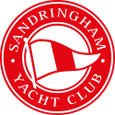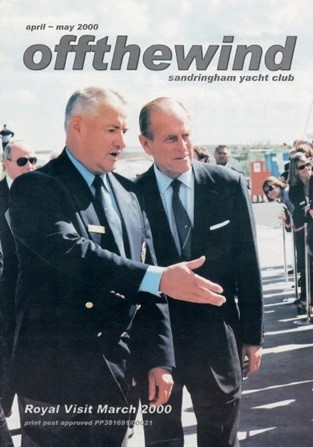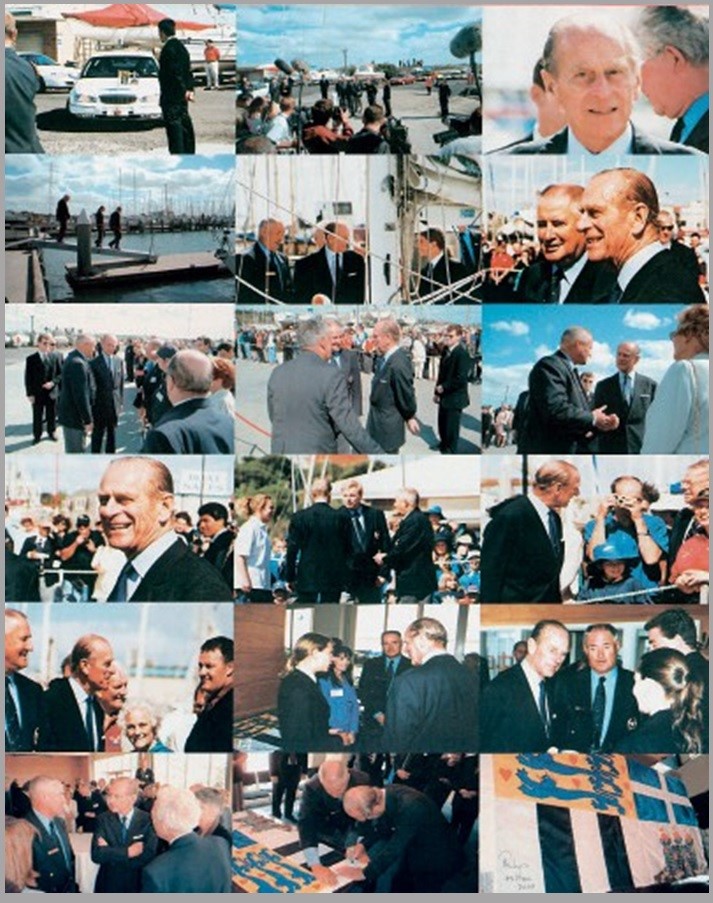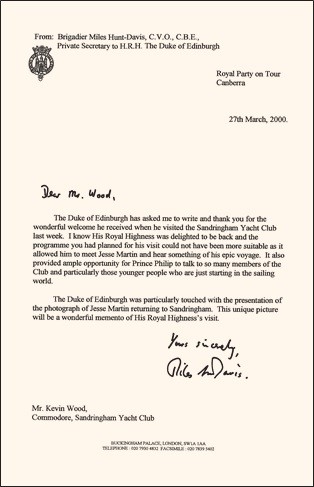Monday, 12th April 2021
His Royal Highness The Prince Philip, Duke of Edinburgh and Consort of Her Majesty The Queen, has died in Windsor. As Consort of The Queen, the Australian Head of State and Head of The Commonwealth of Nations, he occupied a significant world role. His was always a voice to be listened to and his comments, on a wide variety of public and global matters, ensured attention and sometimes controversy. In addition to his role of Royal Consort, he was also the Patron of many organisations and learned bodies. Of particular interest to Australia, might be singled out the Duke of Edinburgh’s Award scheme and his long sustained interest in the complex relationship between humanity and the environment.
His Royal Highness graciously accepted the invitation to become Commodore-in-Chief of Sandringham Yacht Club (SYC) in 1980. Over many years, he took an active interest in the affairs of the Club and we had the security of knowing that he was always there in times of need.
A true friend of SYC, His Royal Highness visited the Club on three occasions.
The Club was delighted and honoured by a visit during the 1956 Olympic Games. A keen sailor himself, His Royal Highness had raced and won many events in his Dragon Class boat Bluebottle, which was given to the Royal couple as a gift following their wedding. Some of the older members of the Club can remember the excitement when the Prince came to visit. His geniality struck everyone, along with his passion for sailing. Commodore A.D. Mackenzie was on hand to officially greet him and show him around the Club. It was the start of a long relationship between the Club and the Prince.
 Prince Philip arrives at the Club in 1956 to be greeted by Commodore A.D. Mackenzie and to meet the Olympic competitors and club members. Crowds packed Jetty Road and the gateway to the club to get a glimpse of the Duke.
Prince Philip arrives at the Club in 1956 to be greeted by Commodore A.D. Mackenzie and to meet the Olympic competitors and club members. Crowds packed Jetty Road and the gateway to the club to get a glimpse of the Duke.
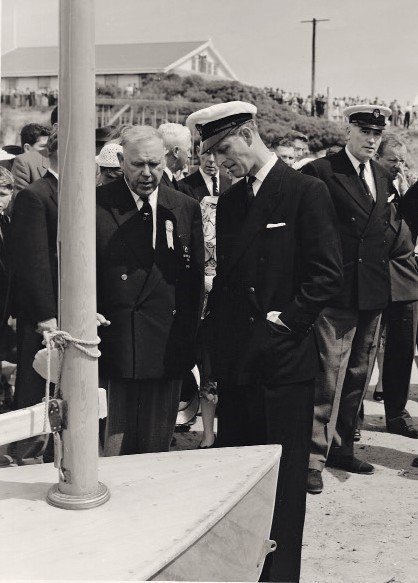 Prince Philip showed great interest in the Finn Class dinghies which SYC hosted as part of the 1956 Olympic Games.
Prince Philip showed great interest in the Finn Class dinghies which SYC hosted as part of the 1956 Olympic Games.
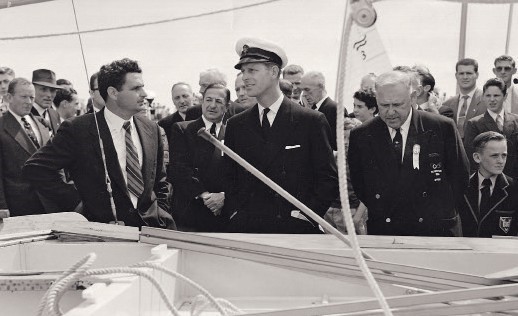 On his 1956 visit, Prince Philip also discussed catamarans with Frank Strange and Commodore A.D. Mackenzie.
On his 1956 visit, Prince Philip also discussed catamarans with Frank Strange and Commodore A.D. Mackenzie.
In early 1980, the Club received a letter from Buckingham Palace stating that His Royal Highness The Duke of Edinburgh had accepted the Club’s invitation to become Commodore-in-Chief of Sandringham Yacht Club. Prince Philip, a distinguished sailor and yachtsman renowned for his interest in youth, next visited the Club on Thursday 29 May 1980. The day loomed grey and cool, with a forecast of light showers. Gatekeeper Jim Howes was on duty soon after 8.30 to supervise and streamline the traffic into the Club grounds. Final touches were carried out at the clubhouse by a band of helpers. As the time drew near for Prince Philip’s appearance, the subdued undercurrent of chatter reached great heights.
More than 1,000 children, mostly from local schools, lined Jetty Road from Beach Road to the clubhouse. At last, the motor cavalcade drew near, coming to a halt inside the clubhouse gates.
Commodore Ron White presented Prince Philip to the Officers of SYC and the President of the Associates, Ngaio Price. He then introduced cadet chairman Graeme Disney and cadet captain Michael Gotts. The cadets formed a guard of honour and Prince Philip moved along the line, stopping to chat with the boys at regular intervals. He was particularly interested in hearing of the success of Barclay Nettlefold and Michael Cooke in winning the International Cadet National Championships in Hobart. Their yacht was rigged and displayed on the Club’s front lawn. Barclay, as skipper, was a tall teenager, while his crew, Michael, about five years younger, was a smaller lad. Observing this, the Duke asked “Do you put lead in his knickers when you race him?”
At the main entrance to the Club, Prince Philip was presented to the permanent members of the office staff before moving to the main bar lounge, where he took a lively interest in the Club’s historical displays, which included a number of national and international trophies. In the main lounge, Prince Philip was presented to the official guests and members. With formalities disposed of, Prince Philip left this huge gathering of people by the external staircase to the car park, where he was introduced to Eric Mackenzie and Warren Smith. After a brief chat with these two yard officers, he walked the length of the yard to the trailer launching ramp, where members of the OTB fleet were assembled. It was here that OTB captain Peter Takle was able to give HRH an outline of this area of the Club, and the various boats.
The Prince then strolled along the marina, where some of the larger craft owned by Club members were on display. A huge crowd of people gave him a fitting send-off with a resounding three cheers. He exchanged farewells before heading back to Government House. Members and guests assembled in the main lounge and continued their celebration. That year, included in the racing calendar was an inaugural event named the Commodore-in-Chief’s Trophy.
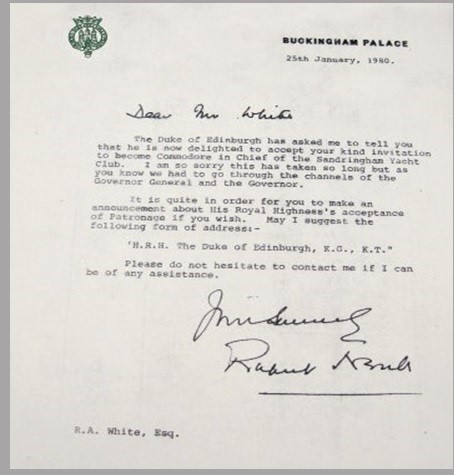 Letter from Buckingham Palace advising the club of Prince Philip’s acceptance of the role of Commodore-in-Chief of the Sandringham Yacht Club.
Letter from Buckingham Palace advising the club of Prince Philip’s acceptance of the role of Commodore-in-Chief of the Sandringham Yacht Club.
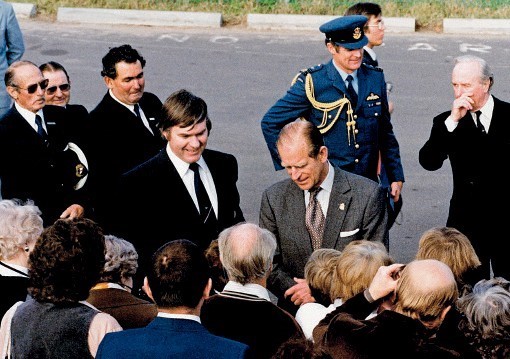 The Duke of Edinburgh on his second Royal visit to the club in May 1980 to accept the position of Commodore-in-Chief. He took a great interest in the junior sailors and chatted at length with cadet members. (L to R) Ray Elsegood (Rear Commodore), Arthur Kilpatrick (Vice Commodore), Ron White (Commodore), Graeme Disney (OTB Chairman), Commander Michael Parker.
The Duke of Edinburgh on his second Royal visit to the club in May 1980 to accept the position of Commodore-in-Chief. He took a great interest in the junior sailors and chatted at length with cadet members. (L to R) Ray Elsegood (Rear Commodore), Arthur Kilpatrick (Vice Commodore), Ron White (Commodore), Graeme Disney (OTB Chairman), Commander Michael Parker.
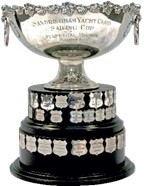 Commodore-in-Chief’s Trophy Instigated in 1980/81 to commemorate the acceptance by H.R.H. The Duke of Edinburgh as Commodore-in-Chief of SYC.
Commodore-in-Chief’s Trophy Instigated in 1980/81 to commemorate the acceptance by H.R.H. The Duke of Edinburgh as Commodore-in-Chief of SYC.
In May 2000, Commodore Kevin Wood welcomed His Royal Highness The Prince Philip, Duke of Edinburgh and Commodore-in-Chief of Sandringham Yacht Club, on his third visit to the Club.
He met with Jesse Martin, and showed considerable interest in his yacht Lionheart, which was moored alongside the hardstand, and congratulated him on his achievement. Prince Philip also met a number of junior members in the OTB area, talked with members along the walkway and mingled with General Committee members, Past Commodores and guests during afternoon tea. He presented the Club with his personal standard, and Commodore Wood, on accepting the gift, invited him to sign the standard, which is on display in the Club. As a memento of his visit, Prince Phillip was presented with a signed copy of the panorama photograph of Jesse Martin’s return to Sandringham Yacht Club upon completion of his epic voyage.
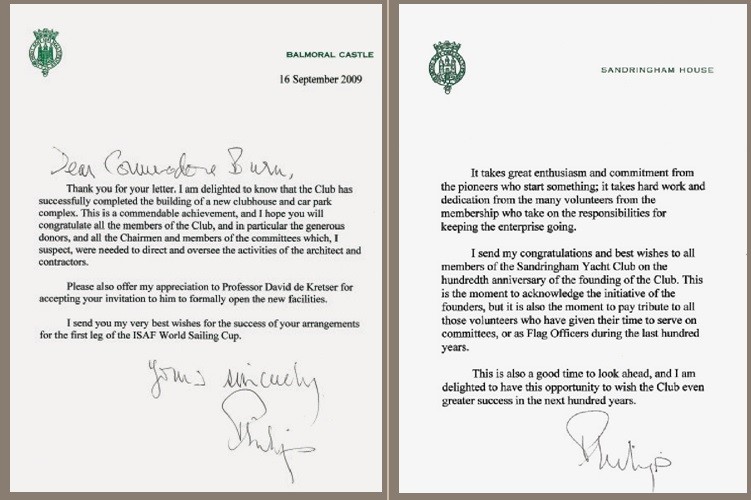 Letter of Congratulations from Prince Philip to Commodore Philip Burn on the Clubhouse redevelopment in 2009.
Letter of Congratulations from Prince Philip to Commodore Philip Burn on the Clubhouse redevelopment in 2009.
The Duke of Edinburgh was the oldest surviving Great-Great-Grandchild of Queen Victoria, through her second daughter, Alice, Grand Duchess of the small German state of Hesse Darmstadt. As such, he was related in both greater and lesser degrees to all the Royal Houses of Europe. His Grandmother, Victoria Alberta of Hesse was the sister of the last Czarina of Imperial Russia and the tragic fate of the Czarina Alexandra and her family was something which always affected this branch of his family.
Philipos of Schleswig-Holstein-Sonderburg-Glucksburg, Royal Prince of Greece and Denmark was born on the island of Corfu on 10th June 1921, the only son and fifth child of Andrew, Prince of Greece and Denmark, and of Princess Alice of Battenberg. He was the nephew of the reigning King of The Hellenes (Greece). Prince Philip’s maternal grandfather was Louis Mountbatten (Battenberg), a naturalised British subject of German origin, who had a long and distinguished career in the Royal Navy. In the turmoil of the aftermath of the First World War, Prince Andrew and his family were banished from Greece and settled in Paris.
In 1928, Prince Philip was sent to be educated in the United Kingdom living mainly with his grandmother at Kensington Palace. At the age of eighteen, he joined the Royal Navy and graduated from Dartmouth, in 1940, as the top cadet in his course. He saw active service in the Second World War in several areas of conflict and was mentioned in despatches. Prince Philip was present in Tokyo Bay for the signing of the Japanese surrender of 1945.
Prince Philip and Her Majesty The Queen, knew each other for most of their lives. They were blood relatives, or third cousins through Queen Victoria and second cousins once removed, through Christian IX, King of Denmark. Their romance dated from the period of the end of the Second World War, although their engagement was not announced until July 1947. Prince Philip renounced his Greek and Danish Royal Titles, assumed the surname of Mountbatten and British Nationality and converted to Anglicanism. His Father-in-Law, King George VI, bestowed on him the title of His Royal Highness and created him Duke of Edinburgh, Earl of Merioneth and Baron Greenwich in the Peerage of the United Kingdom. It was expected that the Duke and Duchess of Edinburgh would have had a number of years together before Princess Elizabeth became Queen. This was not to be and with the death of King George VI on 6 February 1952, the reign of Queen Elizabeth II began.
His Royal Highness The Prince Philip, Duke of Edinburgh, was the longest serving Consort in the history of the British monarchy. He was recognised by his wife, the Head of the Windsor Dynasty, as the head of her immediate family with place, pre-eminence, and precedence. As Consort to The Queen, Prince Philip supported her in her duties as Monarch and Head of The Commonwealth and he accompanied her on all ceremonial occasions, giving up his own career upon her accession. The future of the monarchy in direct line was assured through the birth of three sons and a daughter to the royal marriage.
As early as 1956, the Duke of Edinburgh decided to pursue interests of his own. In that year, he founded the Duke of Edinburgh Awards, opened the Olympic Games in Melbourne and visited the Antarctic. He became Patron of a large number of organizations and, at the time of his death, these numbered more than eight hundred bodies. His interests were in technology and industry, but not exclusively. He was, on a global basis, President of the World Wildlife Fund.
With the passing of His Royal Highness The Duke of Edinburgh, The United Kingdom, The Commonwealth and the world have lost a significant personage whose opinions were always sought and listened to in a variety of areas. This does not mean that they attracted universal agreement as, His Royal Highness would have been the first to admit, he was an intelligent man without the sometimes dubious benefits of an extremely formal education but he had the ability to reason and to seek out opinions. He was an extraordinary Consort who managed to lead his own life as well as providing an unswerving and loyal support to his wife, The Queen.
We, in Sandringham Yacht Club, are honoured to have had him as our Commodore-inChief and thereby to have participated and benefited from the life of one of the most significant figures of the twentieth and twenty first centuries.
This tribute was compiled with contributions from Under Full Sail SYC Centenary Book, Life Member Phil Spry-Bailey and Club Historian Graeme Disney
